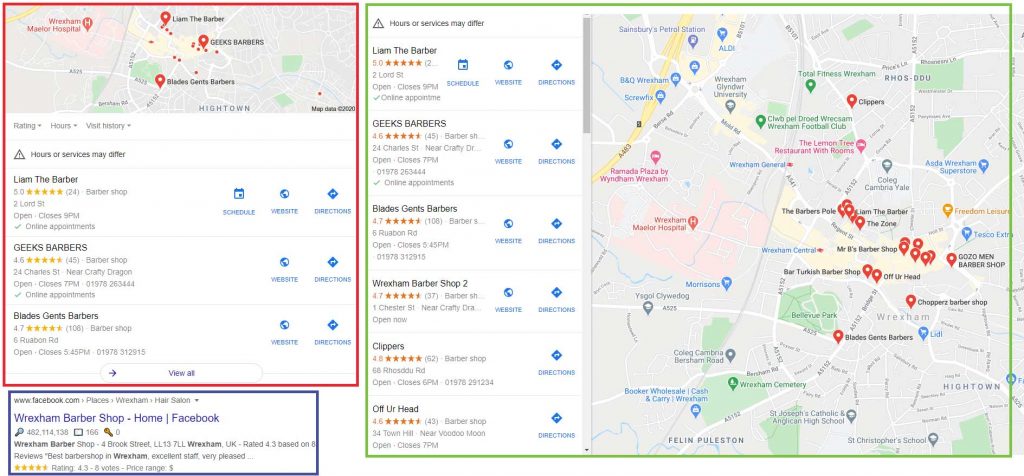Local search is powerful for small businesses. It is estimated that four out of five consumers use search to find local information, which means if your business is nowhere to be seen on the Internet or isn’t optimised for local search, you could be missing out on 80% of your potential customer base.
If we put ourselves into the consumers’ shoes, many of us will be part of the above statistic. For example, when you’re new to an area and looking for places to eat in walking distance from where you’re staying, do you Google it? If you want to check whether a local supermarket is open, or find the telephone number for a locksmith, do you Google it? If you answered yes to both, you’re not alone! 46% of all Google searches are looking for local information. That’s over 2.7 billion searches a day. And it’s not just Google. All search engines want to connect customers to local businesses, which is why they all offer a platform that shows users relevant results for their current geographic location. They know, for instance, that people aren’t prepared to travel halfway across the country just to grab a burger and chips (even if it is a good burger and chips). Users need reasonable and relevant options that are close by.
At Whitespark’s Local Search Summit in September 2020, Darren Shaw announced the initial findings of his latest Local Search Ranking Factors survey. This annual survey polls around 50 local SEO experts, asking for their opinions on which activities and factors impact local business rankings.
In this article, we’ll explore the following topics:
- What is Local SEO?
- Why is Local SEO important?
- How does Local SEO work?
- The top local ranking factors for 2020 (as polled in the survey)
- How Wrexham Tech can help.
What is Local SEO?
Local SEO is the marketing strategy that aims to rank your website pages, products and services higher in the search results for geographically specific keywords, like Wrexham or London.
Unlike regular SEO where the focus is more towards a general Internet audience, Local SEO homes in on users searching for products or services locally. For example, if a user searches for “barbers near me”, search engines will show the results of businesses nearby in regular search and on maps, providing that location settings is turned on.
By focusing more on location, businesses can better target their key audience and nurture them into paying customers.
So what does Local SEO look like? When a search is submitted on Google, just underneath the advertisement area, you’ll see the section in red commonly referred to as the ‘Local 3 Pack’ or ‘Map Pack’, and then the organic results in blue. But that’s not the only place that search is influenced by Local SEO. Searchers often use Google Maps to find local businesses (marked in green). Getting your business ranking in Google’s ‘Local 3 Pack’ or on the maps for your specific service will help attract local customers who are ready to buy.

What Local SEO looks like for the user when searching for ‘barbers in wrexham’.
Why is Local SEO important?
Many businesses rely on the local community for their customers. Hairdressers, dentists, restaurants to name a few. These businesses all know that their customers are exclusively people who are close by. This fact alone proves the importance of Local SEO. For these businesses, it only makes sense to target relevant prospects in the immediate area. There’s no point in these local businesses burning precious marketing £’s appealing to users who live hundreds of miles away.
Beyond targeting local customers, local search can also help independent brick-and-mortar businesses compete against nationwide online rivals.
From 4,500 people surveyed, Google found that 30% of people would prefer to purchase in-person instead of online if they knew they were close to a store. A further 35% said that they’d willingly part with their cash if they knew they could get the product they wanted quicker.
Top tip: As mentioned earlier on in this article, almost 50% of Google searches have local intent. With this comes competition. Since COVID-19, due to temporary closure and decrease in profit, many businesses have had to make cuts in local search. Therefore, if you haven’t invested in Local SEO yet, now may be the best time before the competition increases again.
How does Local SEO work?
At a high-level, Local SEO works like a ‘normal’ Google search. When a person searches, Google scans through its index to provide the best results for that person’s query. What makes Local SEO unique is that Google uses a different set of ranking factors to rank the local search results. These include:
- The location that the person is searching from
- NAP citations (details such as business name, address and phone number showing on local directory websites such as Yell, Yelp and Thomson Local)
- Presence of Google My Business listing
- Keywords used in Google My Business profile
- Sentiment of online reviews
- Keywords used in online reviews
- Number of “check-ins” at that location
- Shares on social media
- Google Maps star rating for that business.
The more of the above that you can tick off, the more likely that the search engine will try and connect your business with searchers that live locally.
The top local ranking factors for 2020
At Whitespark’s Local Search Summit in September 2020, Darren Shaw announced the initial findings of his latest Local Search Ranking Factors survey. This annual survey polls around 50 local SEO experts, asking for their opinions on which activities and factors impact local business rankings. Here is what he found:
- The most important grouped factors for local pack rankings are: 1) Google My Business, 2) Reviews, 3) On-page optimisation, 4) External Links
- Google My Business has grown importance since 2018 – rising from 25% of local pack ranking factors to 33% in 2020
- Online reviews are now the second most important factor for local pack rankings – overtaking external links.
In short, there are a great many local search ranking factors that influence how well a business ranks, and there’s no magic bullet that will get you and your business to the top of local search results. Local SEO takes time, knowledge, and ongoing effort to get right – it should never be a case of “set it and forget it”.
How Wrexham Tech can help
At Wrexham Tech, we cannot understate the importance of Local SEO, particularly for businesses relying on local trade. People can order a laptop from any online website, irrespective of their location. But they can’t do the same for a haircut.
Whether you’re a service, a brick and mortar business or an online retailer selling locally, appearing in Google’s ‘Local 3 Pack’ is a must. If you’re not seeing yourself in the top, you’re leaving a lot on the table. Ranking in the ‘Local 3 Pack’ can bring unprecedented exposure to your business. As this article has shown, businesses that optimise for Local SEO put themselves at a distinct advantage. If your business is nowhere to be seen on the Internet or isn’t optimised for local search, you could be missing out on 80% of your potential customer base. If you’re a new or existing business, we can help increase your local visibility, and help get your business ranked in Google’s ‘Local 3 Pack’ for more leads, more sales and more traffic. For more information on how we can help you, please contact us today.




